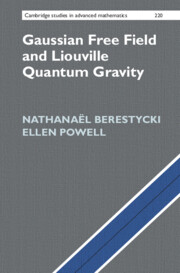Refine search
Actions for selected content:
3044 results in Probability theory and stochastic processes
3 - Gaussian Multiplicative Chaos
-
- Book:
- Gaussian Free Field and Liouville Quantum Gravity
- Published online:
- 20 November 2025
- Print publication:
- 04 December 2025, pp 75-132
-
- Chapter
- Export citation
Appendix C - Radial Loewner Chains and Radial SLE
-
- Book:
- Gaussian Free Field and Liouville Quantum Gravity
- Published online:
- 20 November 2025
- Print publication:
- 04 December 2025, pp 391-395
-
- Chapter
- Export citation
Appendix A - Chordal Loewner Chains and Chordal SLE
-
- Book:
- Gaussian Free Field and Liouville Quantum Gravity
- Published online:
- 20 November 2025
- Print publication:
- 04 December 2025, pp 373-381
-
- Chapter
- Export citation

Gaussian Free Field and Liouville Quantum Gravity
-
- Published online:
- 20 November 2025
- Print publication:
- 04 December 2025
4 - Large Deviations
-
- Book:
- Probability Theory for Quantitative Scientists
- Published online:
- 24 July 2025
- Print publication:
- 14 August 2025, pp 91-116
-
- Chapter
- Export citation
3 - Law of Large Numbers and Central Limit Theorem
-
- Book:
- Probability Theory for Quantitative Scientists
- Published online:
- 24 July 2025
- Print publication:
- 14 August 2025, pp 43-90
-
- Chapter
- Export citation
6 - Multivariate and Correlated Experimental Data
-
- Book:
- Probability Theory for Quantitative Scientists
- Published online:
- 24 July 2025
- Print publication:
- 14 August 2025, pp 161-187
-
- Chapter
- Export citation
1 - Introduction to Probability
-
- Book:
- Probability Theory for Quantitative Scientists
- Published online:
- 24 July 2025
- Print publication:
- 14 August 2025, pp 1-22
-
- Chapter
- Export citation
14 - Entropy, Probability, and Statistical Mechanics
-
- Book:
- Probability Theory for Quantitative Scientists
- Published online:
- 24 July 2025
- Print publication:
- 14 August 2025, pp 357-396
-
- Chapter
- Export citation
References
-
- Book:
- Probability Theory for Quantitative Scientists
- Published online:
- 24 July 2025
- Print publication:
- 14 August 2025, pp 397-401
-
- Chapter
- Export citation
8 - Generating Functions and Chain Reactions
-
- Book:
- Probability Theory for Quantitative Scientists
- Published online:
- 24 July 2025
- Print publication:
- 14 August 2025, pp 217-229
-
- Chapter
- Export citation
7 - Random Walkers
-
- Book:
- Probability Theory for Quantitative Scientists
- Published online:
- 24 July 2025
- Print publication:
- 14 August 2025, pp 188-216
-
- Chapter
- Export citation
Frontmatter
-
- Book:
- Probability Theory for Quantitative Scientists
- Published online:
- 24 July 2025
- Print publication:
- 14 August 2025, pp i-iv
-
- Chapter
- Export citation
13 - Continuous-Time Markov Processes
-
- Book:
- Probability Theory for Quantitative Scientists
- Published online:
- 24 July 2025
- Print publication:
- 14 August 2025, pp 335-356
-
- Chapter
- Export citation
Contents
-
- Book:
- Probability Theory for Quantitative Scientists
- Published online:
- 24 July 2025
- Print publication:
- 14 August 2025, pp v-viii
-
- Chapter
- Export citation
Preface
-
- Book:
- Probability Theory for Quantitative Scientists
- Published online:
- 24 July 2025
- Print publication:
- 14 August 2025, pp ix-x
-
- Chapter
- Export citation
Guide for Instructors
-
- Book:
- Probability Theory for Quantitative Scientists
- Published online:
- 24 July 2025
- Print publication:
- 14 August 2025, pp xi-xiv
-
- Chapter
- Export citation
5 - Statistical Inference and Experimental Data Analysis
-
- Book:
- Probability Theory for Quantitative Scientists
- Published online:
- 24 July 2025
- Print publication:
- 14 August 2025, pp 117-160
-
- Chapter
- Export citation
10 - Markov Chains
-
- Book:
- Probability Theory for Quantitative Scientists
- Published online:
- 24 July 2025
- Print publication:
- 14 August 2025, pp 249-288
-
- Chapter
- Export citation
Index
-
- Book:
- Probability Theory for Quantitative Scientists
- Published online:
- 24 July 2025
- Print publication:
- 14 August 2025, pp 402-412
-
- Chapter
- Export citation
